Can you freeze cornbread? Freezing cornbread is a fantastic way to extend the shelf life of this classic American side dish. In this article, I will share everything you need to know about freezing, thawing, and reheating this delicious quick bread.
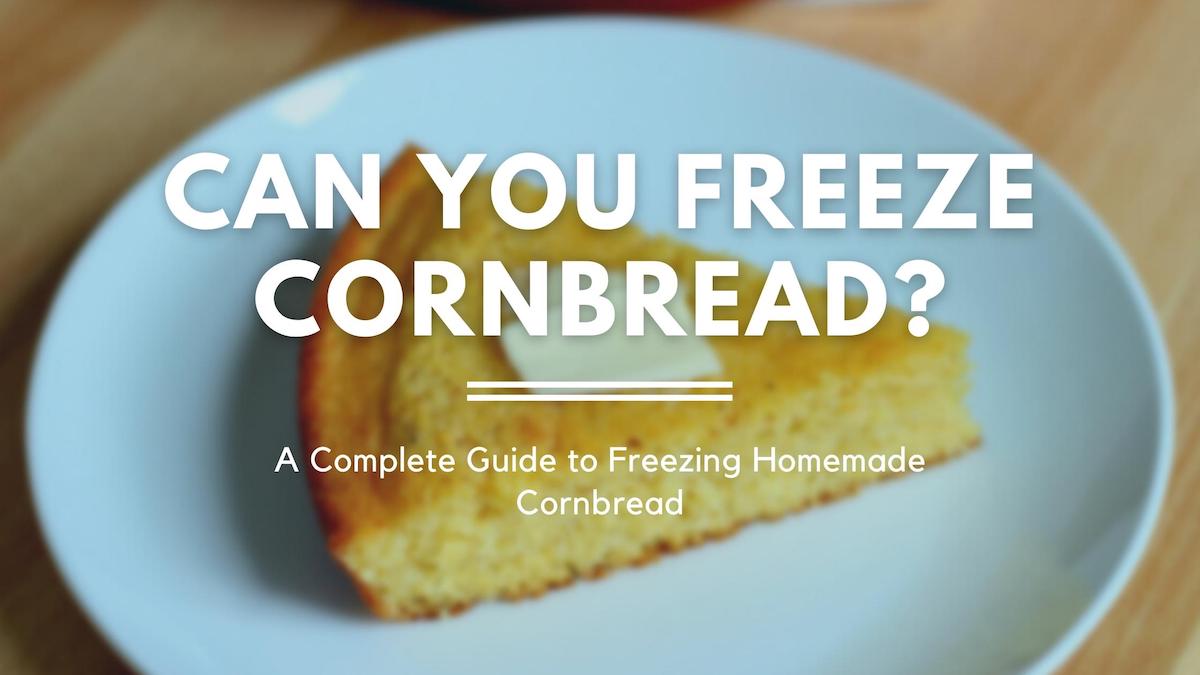
Have you found yourself with a bunch of leftover cornbread and now you're wondering whether or not you can freeze it?
Well, you're in luck! Yes, you can freeze cornbread. In fact, it freezes quite well. Freezing cornbread is an excellent way to preserve this lightly sweetened quick bread for future enjoyment.
So, if you're looking for a way to save some extra cornbread that's about to spoil, keep reading to learn all about freezing and reheating this tasty side dish.
Looking for a quick and easy cornbread recipe? Try my Brown Butter Skillet Cornbread.
Disclaimer: Some links throughout this post are affiliate links. As an Amazon Associate, I earn from qualifying purchases. You can learn more by visiting my Affiliate Disclosure Page.
What is Cornbread?
Cornbread is a popular America quick bread usually served as a side dish. More commonly consumed in the southern part of the United States, cornbread actually originated from the Native American people.
Traditional cornbread was made with just cornmeal and water. Today, it is often made from cornmeal, flour, baking powder, buttermilk, eggs, and sometimes sugar.
How Long Does Cornbread Last?
Cornbread has a relatively short shelf life. Depending on the temperature and humidity in your home, cornbread can last anywhere from one day to several months in the freezer.
Room Temperature
Allow the cornbread to cool completely before storing it in an airtight container for up to 3 days at room temperature.
If your home is especially warm and humid, I don't recommend storing it for longer than one day at room temperature.
Refrigerator
Store cornbread in an airtight container in the refrigerator for up to one week.
While storing cornbread in the refrigerator can extend its shelf life by a few days, the cool and dry environment of the refrigerator will stale cornbread more quickly. I do not recommend storing cornbread in the refrigerator.
Freezer
Freezing cornbread is the best way to extend its shelf life without drying it out.
Cornbread stored in the freezer will maintain optimal quality for up to 3 months. It will be safe to eat beyond that time, but the quality may start to become affected.
Keep reading below to learn how to freeze cornbread.
Can You Freeze Cornbread?
Yes, you certainly can freeze cornbread. And if you're not going to be eating it within a day or two of baking, I actually recommend freezing it.
Benefits of Freezing Cornbread
- Longer Shelf Life- Learning how to properly freeze cornbread will extend its shelf life by a few months. Not only will this reduce food waste, but it will help you save money too.
- Save Time- Cornbread is the perfect make-ahead, freezer-friendly side dish. Often, I like to make a double batch of cornbread so I can store leftovers in the freezer. Then, on nights I don't feel like cooking, I have a quick, easy, and delicious side dish ready to go.
- Holiday Meal Prep- Speaking of saving time, making cornbread to store in the freezer is an easy way to get a head start on holiday cooking. If you serve cornbread stuffing with your Thanksgiving turkey, you'll be one step ahead with a loaf of homemade cornbread in the freezer.
How to Freeze Cornbread
Freezing cornbread could not be any easier. All you need is some plastic wrap, a freezer-safe container, and a way to mark the date. Here are 4 steps you can follow to properly freeze cornbread.
Step 1: Allow the Cornbread to Cool Completely
Allow the leftover cornbread to cool completely on the counter before covering or wrapping it. Making sure the bread cools completely prevents condensation from collecting on the plastic wrap.
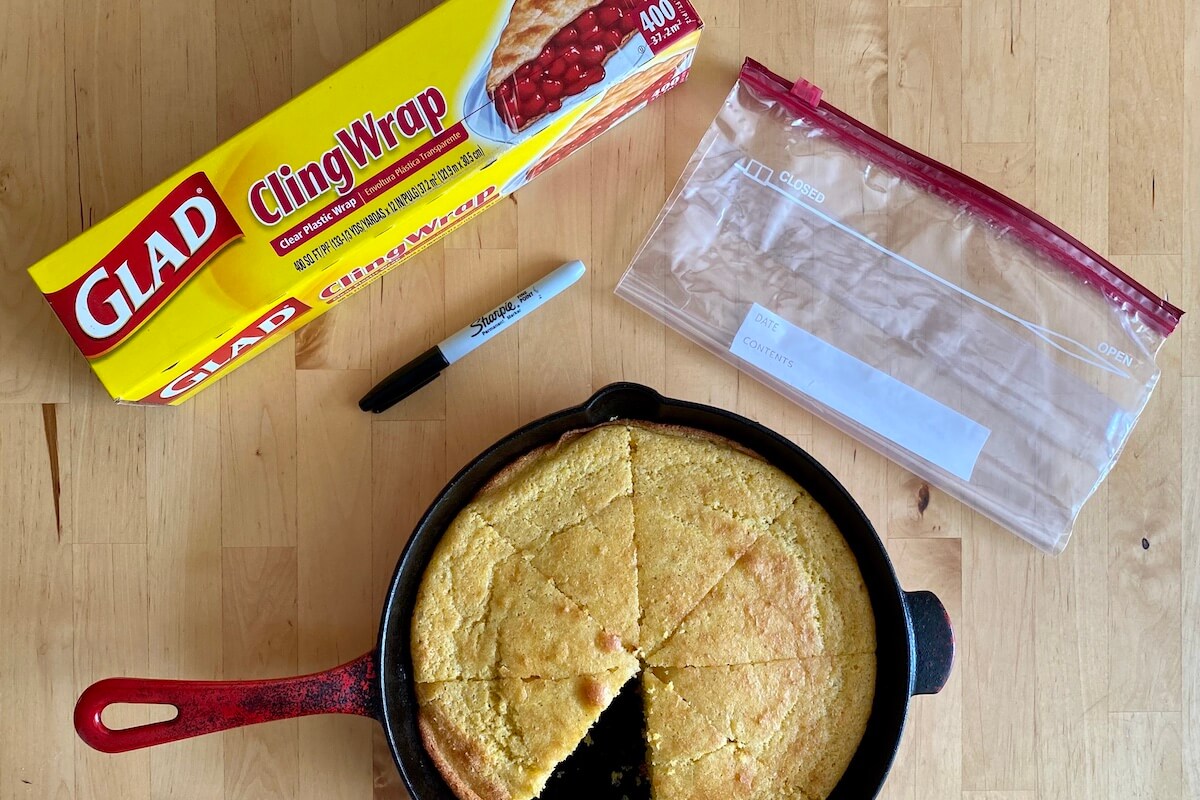
Step 2: Portion and Wrap
Wrap cornbread in either plastic wrap or beeswax wrap. You can wrap the whole loaf of cornbread or cut it into individual slices. I prefer wrapping individual slices for easier portion control.
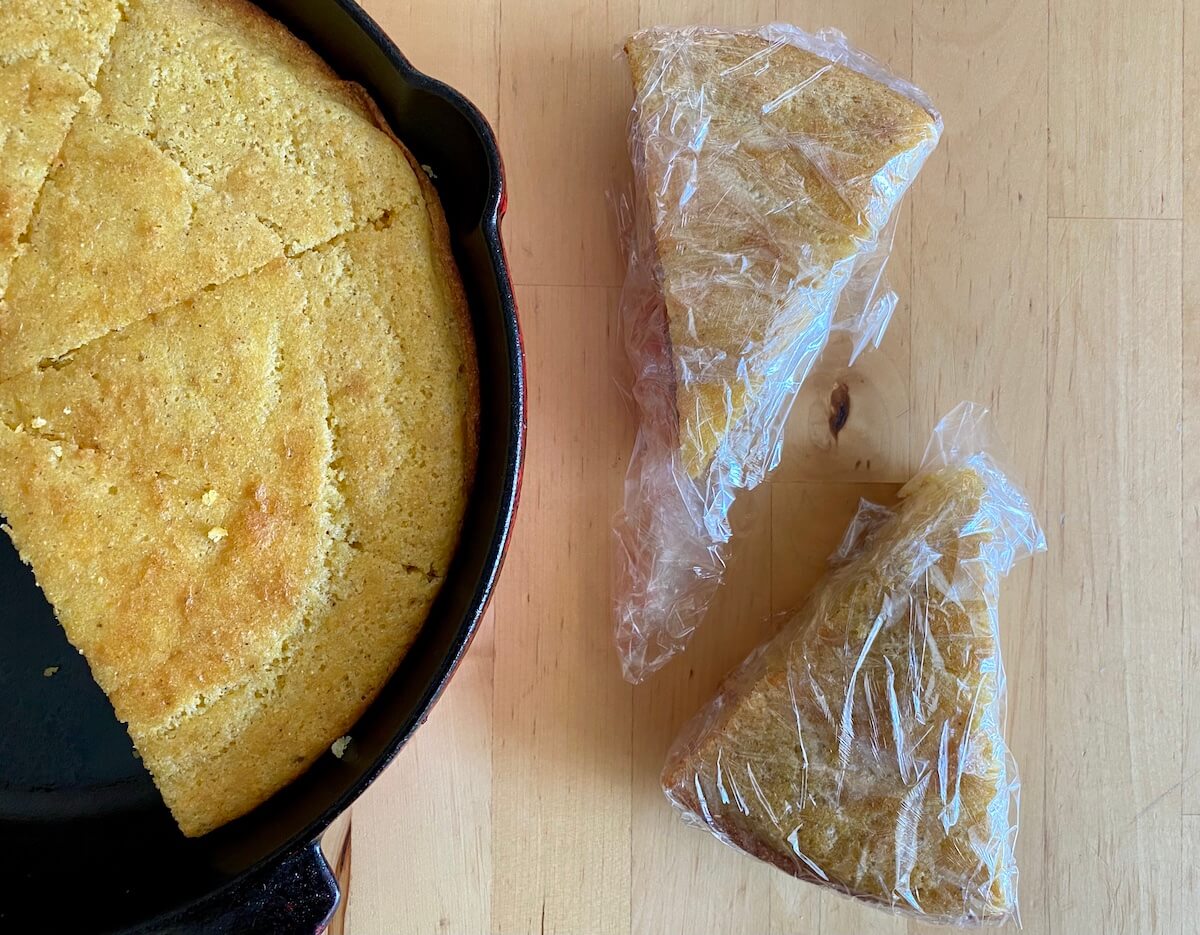
Step 3: Package and Date
Place the wrapped cornbread inside a freezer-safe plastic bag or container. The double wrapping helps to prevent freezer burn. Don't forget to label and date the cornbread so you'll know when you need to eat it by.
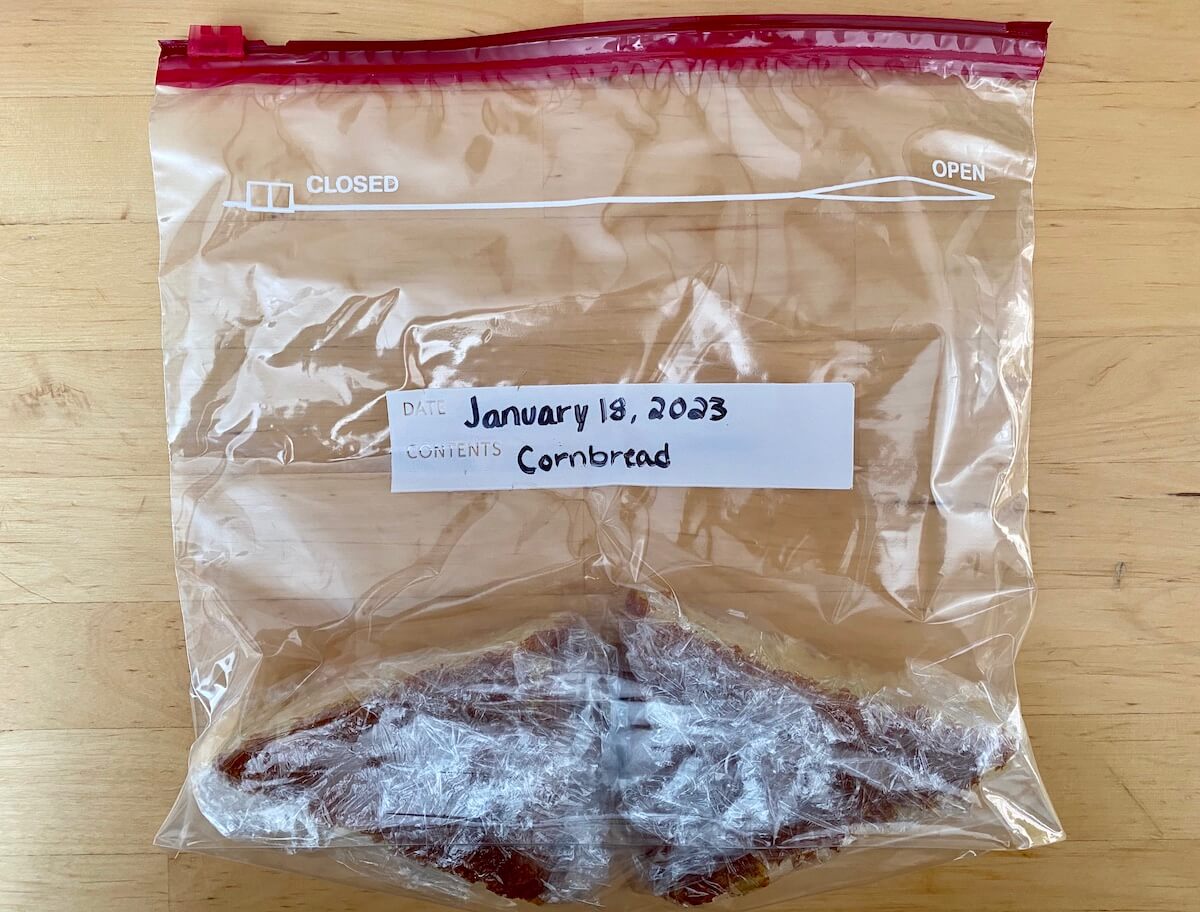
Step 4: Freeze
Store the cornbread in the freezer for up to 3 months for optimum quality.
4 Tips for Freezing Leftover Cornbread
- Freeze Quickly- If you know you're not going to finish all of the cornbread within a day or two, it's best to freeze it as quickly as possible. Getting the cornbread in the freezer as soon as it is cool will ensure optimum quality for a longer amount of time.
- Wrap Individual Portions- Cutting the cornbread into individual portions before storing will allow you to thaw and reheat only what you plan on eating.
- Don't Forget the Date- I can't tell you how many times I throw something in my freezer without a label and date, then completely blank on what it is or how long it has been in there. Labeling and dating your cornbread before freezing it will keep you from the same unfortunate fate.
- Double Wrap- It may seem like overkill, but wrapping the cornbread in plastic wrap, then again in a plastic freezer bag or container helps avoid freezer burn and off-flavors.
How to Thaw Frozen Cornbread
Okay, so your cornbread is frozen. Now, how do you thaw it?
Thawing frozen cornbread only requires a little patience. The best way to defrost frozen cornbread is to place it in the refrigerator to thaw overnight. You can also thaw it on the counter at room temperature for an hour or two.
Just be sure to leave it wrapped while thawing to prevent excess moisture loss.
How to Reheat Frozen Cornbread
For best results with all reheating methods, allow the frozen cornbread to thaw in the refrigerator overnight. However, the oven, toaster oven, and microwave can be used to reheat cornbread straight from frozen.
>> Want to learn the 6 best methods for reheating cornbread without drying it out? Check out my article on How to Reheat Cornbread.
Oven/Toaster Oven
Preheat the oven or toaster oven to 350°F.
Wrap individual slices of cornbread in aluminum foil or place the slices on a baking sheet and cover tightly with aluminum foil. You can dot the cornbread with butter or spritz it with a bit of water to help moisten the bread if desired.
Bake for 10 minutes or until warmed through. If frozen, you may need to bake for an additional 5-10 minutes.
Stovetop
Melt a tablespoon of butter in a skillet over medium-low heat. Place individual slices of cornbread in a single layer in the skillet.
Cook on one side for 3-4 minutes or until the cornbread is golden brown and toasted. Flip and warm through on the other side for an additional minute or so.
Microwave
Place a single serving of cornbread on a microwave-safe plate. Wrap the cornbread in a damp paper towel and microwave on half-power (50%) for 1 to 1 ½ minutes or until fully warmed through.
If your cornbread is frozen, you may need to microwave it for an additional 30-60 seconds.
Air Fryer
Wrap individual slices of cornbread in aluminum foil and place them inside the basket of an air fryer. Set the air fryer to 350°F and reheat the cornbread for 4-5 minutes or until warmed through.
Toaster
Place slices of cornbread in the toaster and toast for 2-3 minutes.
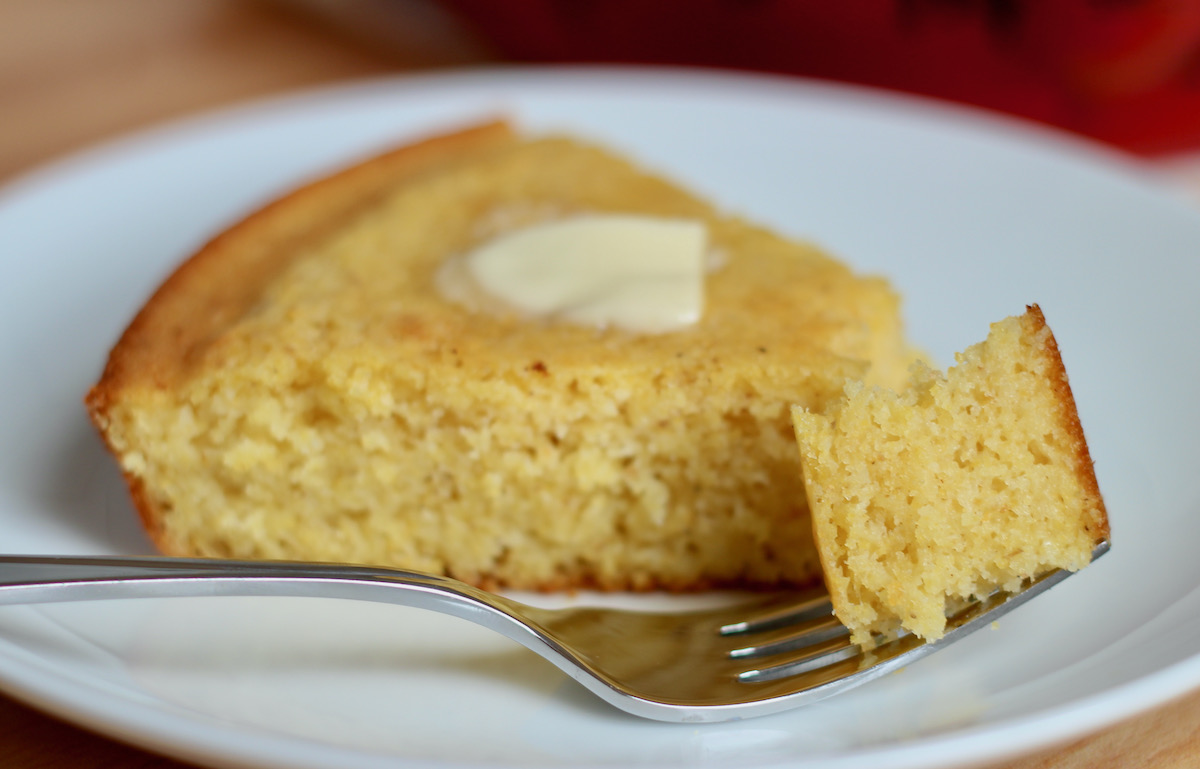
Can You Refreeze Cornbread?
Yes, technically you can refreeze previously frozen cornbread. However, the quality will be significantly degraded each time you do so. For this reason, I recommend freezing individual portions of leftover cornbread so you can easily reheat only what you want to eat in one sitting.
How Can You Tell If Cornbread Is Bad?
The high amount of moisture in cornbread means that it has a relatively short shelf life, especially at room temperature. Made with eggs and dairy, cornbread can quickly become spoiled and unsafe to eat.
Here are a few ways you can tell if your cornbread has gone bad:
- Moldy- If you see visible signs of mold on your cornbread, toss the whole pan or loaf. Mold is a sure sign cornbread has gone bad.
- Sticky or Stringy- Cornbread that looks or feels sticky, soggy, or overly moist is likely past its prime. Another sign to look for is thin, web-like strands that briefly connect the bread when broken apart. If you see these, it's best to throw the loaf out.
- Odor- If the cornbread smells sour, your best bet is to say farewell.
- Stale- While not technically bad, stale cornbread is unpleasant to eat. You'll know your cornbread is stale if it's dry, crumbly, and hard to eat.
How to Use Up Leftover Cornbread
As one of my favorite side dishes, cornbread doesn't often last long over here. However, if you have an abundance of cornbread you're trying to use up, here are a few fun ideas to get your creativity flowing.
- Dressing or Stuffing
- Croutons
- Breadcrumbs
- Cornbread Pudding
- Mexican Cornbread Casserole
- Fritters
- Panzanella
- French Toast
- Cornbread Breakfast Quiche
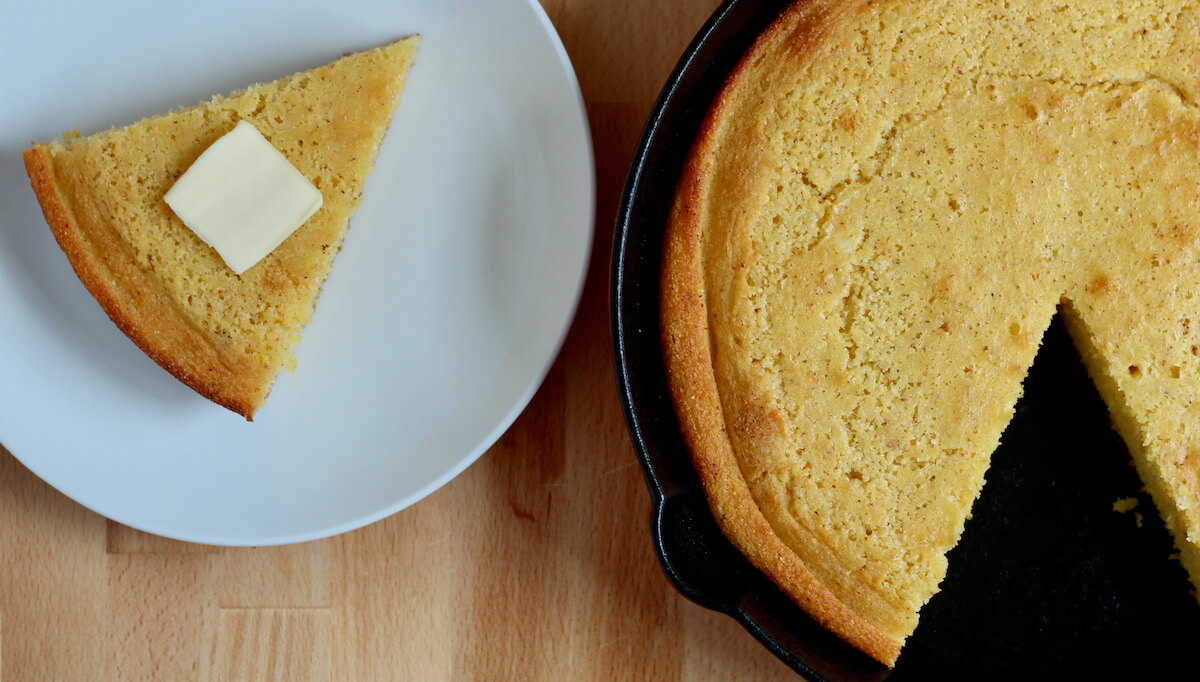
Frequently Asked Questions
If you plan on eating it within a day or two, keeping it on the counter in an airtight container is your best bet. Otherwise, freezing your leftover cornbread would be the better option.
Yes, you can eat cold or room temperature cornbread. But, the colder the cornbread is, the more dry and crumbly the texture will be. I highly recommend using one of the reheating methods mentioned in the "How the Reheat Frozen Cornbread" section above.
Certainly. You can freeze cornbread muffins just like you would individual slices of cornbread. Simply wrap the muffins in plastic wrap, place them inside a freezer-safe container, date them, and freeze them for up to 3 months.
Cornbread batter can be frozen. I tested making cornbread muffins with cornbread batter that I froze immediately after mixing it. Then, I thawed it overnight in the refrigerator. The muffins were slightly more dense than normal, which is to be expected.
Quick breads, like cornbread, get their rise from baking powder. Baking powder is activated when it comes into contact with liquid. So, the longer you wait to bake the cornbread batter, the less rise it will have.
For best results baking frozen cornbread batter, use a double-acting baking powder, which is activated both when exposed to liquid and when exposed to heat.
According to their website, Jiffy cornbread can be frozen. Jiffy suggests using the baked product within one month of freezing for best results.
Conclusion
To wrap up, freezing homemade cornbread is my favorite method for preserving this delicious side dish. Whether you have leftovers or you are planning ahead, learning how to freeze cornbread properly is key to keeping it as fresh as possible.
Let's Connect!
Be sure to leave a comment below if you have any questions. You can also connect with me on Instagram, Facebook, Pinterest, or via email at [email protected].


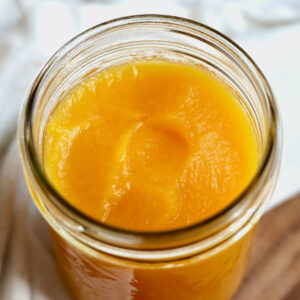
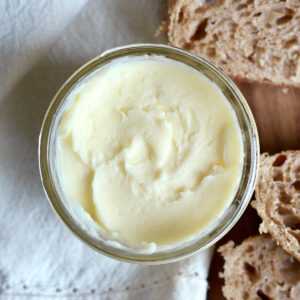

Comments
No Comments